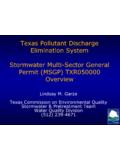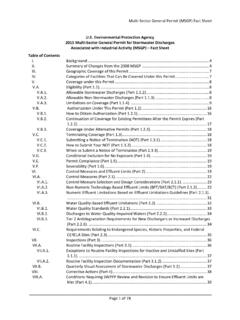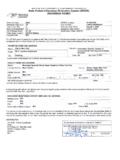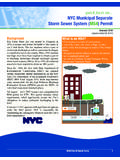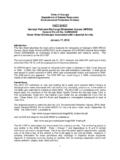Transcription of Multi-Sector General Permit (MSGP)
1 Multi-Sector General Permit ( msgp ) A-1 Appendix A - Definitions, Abbreviations, and Acronyms (for the purposes of this Permit ). DEFINITIONS Action Area all areas to be affected directly or indirectly by the federal action and not merely the immediate area involved in the action. See 50 CFR 402. For the purposes of this Permit and for application of Endangered Species Act requirements, the following areas are included in the definition of action area: The areas where stormwater discharges originate and flow from the industrial facility tothe point of discharge into receiving waters. (Example: Where stormwater flows into aditch, swale, or gully that leads to receiving waters and where listed species (such aslisted amphibians) are found in the ditch, swale, or gully.)
2 The areas where stormwater from industrial activities discharge into receiving waters andthe areas in the immediate vicinity of the point of discharge. (Example: Wherestormwater from industrial activities discharges into a stream segment that is known toharbor listed aquatic species.) The areas where stormwater controls will be constructed and operated, including anyareas where stormwater flows to and from the stormwater controls. (Example: Where astormwater retention pond would be built.) The areas upstream and/or downstream from the stormwater discharge into a streamsegment that may be affected by these discharges. (Example: Where sedimentdischarged to a receiving stream settles downstream and impacts a breeding area of alisted aquatic species.)
3 Antidegradation Policy or Antidegradation Requirements the water quality standards regulation that requires States and Tribes to establish a three-tiered antidegradation program: 1 maintains and protects existing uses and water quality conditions necessary tosupport such uses. An existing use can be established by demonstrating that fishing,swimming, or other uses have actually occurred since November 28, 1975, or that thewater quality is suitable to allow such uses to occur. Where an existing use is established,it must be protected even if it is not listed in the water quality standards as a designateduse. Tier 1 requirements are applicable to all surface 2 maintains and protects "high quality" waters -- water bodies where existingconditions are better than necessary to support CWA 101(a)(2) "fishable/swimmable"uses.
4 Water quality can be lowered in such waters. However, state and tribal Tier 2programs identify procedures that must be followed and questions that must beanswered before a reduction in water quality can be allowed. In no case may waterquality be lowered to a level which would interfere with existing or designated 3 maintains and protects water quality in outstanding national resource waters(ONRWs). Except for certain temporary changes, water quality cannot be lowered insuch waters. ONRWs generally include the highest quality waters of the United , the ONRW classification also offers special protection for waters of exceptionalecological significance, , those which are important, unique, or sensitive regarding which water bodies qualify to be ONRWs are made by States andauthorized Indian A-1 of 11 Multi-Sector General Permit ( msgp ) Arid Areas areas where annual rainfall averages from 0 to 10 inches.
5 Bypass the intentional diversion of waste streams from any portion of a treatment facility. See 40 CFR (m)(1)(i). CERCLA Site ( , Superfund Site) - for the purposes of this Permit , a site as defined in Section 101(9) of the Comprehensive Environmental Response, Compensation and Liability Act (CERCLA), 42 9601(9), that is undergoing a remedial investigation and feasibility study, or for which a Record of Decision for remedial action has been issued in accordance with the National Contingency Plan, 40 CFR Part 300. Co-located Industrial Activities any industrial activities, excluding your primary industrial activity(ies), located on-site that are defined by the stormwater regulations at (b)(14)(i)-(ix) and (xi). An activity at a facility is not considered co-located if the activity, when considered separately, does not meet the description of a category of industrial activity covered by the stormwater regulations or identified by the SIC code list in Appendix D.
6 Confidential Business Information (CBI) see 40 CFR Part 2 for relevant definitions of CBI: Control Measures refers to any stormwater control or other method (including narrative effluent limitations) used to prevent or reduce the discharge of pollutants to waters of the United States. Corrective Action for the purposes of the Permit , any action taken, or required to be taken, to (1) repair, modify, or replace any stormwater control used at the site; (2) clean up and dispose of spills, releases, or other deposits found on the site; and (3) remedy a Permit violation. Critical Habitat as defined in the Endangered Species Act at 16 1531 for a threatened or endangered species, (i) the specific areas within the geographical area occupied by the species, at the time it is listed in accordance with the provisions of section 4 of the Endangered Species Act, on which are found those physical or biological features essential to the conservation of the species and which may require special management considerations or protection; and (ii) specific areas outside the geographical area occupied by the species at the time it is listed in accordance with the provisions of section 4 of the Endangered Species Act, upon a determination by the Secretary that such areas are essential for the conservation of the species.
7 Director a Regional Administrator of the Environmental Protection Agency or an authorized representative. See 40 CFR Discharge when used without qualification, means the "discharge of a pollutant." See 40 CFR Discharge of a Pollutant any addition of any pollutant or combination of pollutants to waters of the United States from any point source, or any addition of any pollutant or combination of pollutants to the waters of the contiguous zone or the ocean from any point source other than a vessel or other floating craft which is being used as a means of transportation. This includes additions of pollutants into waters of the United States from: surface runoff which is collected or channeled by man; discharges through pipes, sewers, or other conveyances, leading into privately owned treatment works.
8 See 40 CFR Page A-2 of 11 Multi-Sector General Permit ( msgp ) Discharge Point for the purposes of this Permit , the location where collected and concentrated stormwater flows are discharged from the facility such that the first receiving waterbody into which the discharge flows, either directly or through a separate storm sewer system, is a water of the Discharge-Related Activity activities that cause, contribute to, or result in stormwater and allowable non-stormwater point source discharges, and measures such as the siting, construction and operation of stormwater controls to control, reduce, or prevent pollution in the discharges. Discharge to an Impaired Water for the purposes of this Permit , a discharge to an impaired water occurs if the first water of the to which you discharge is identified by a state, t ribe, or EPA as not meeting an applicable water quality standard, and requires development of a total maximum daily load (TMDL) (pursuant to Section 303(d) of the Clean Water Act), or is addressed by an EPA-approved or established TMDL, or is not in either of the above categories but the waterbody is covered by pollution control requirements that meet the requirements of 40 CFR (b)(1).
9 For discharges that enter a separate storm sewer system prior to discharge, the water of the to which you discharge is the waterbody that receives the stormwater discharge from the storm sewer system. Drought-Stricken Area for the purposes of this Permit , an area in which the National Oceanic and Atomospheric Administration s Seasonal Drought Outlook indicates for the period that any of the following conditions are likely: (1) Drought to persist or intensify , (2) Drought ongoing, some improvement , (3) Drought likely to improve, impacts ease , or (4) Drought development likely . See Effective Operating Condition for the purposes of this Permit , a stormwater control is kept in effective operating condition if it has been implemented and maintained in such a manner that it is working as designed to minimize pollutant discharges.
10 Effluent Limitations for the purposes of this Permit , any of the Part 2 or Part 3 requirements. Effluent Limitations Guideline (ELG) defined in 40 CFR as a regulation published by the Administrator under section 304(b) of CWA to adopt or revise effluent limitations. Eligible for the purposes of this Permit , refers to stormwater and allowable non-stormwater discharges that are authorized for coverage under this General Permit . Endangered Species defined in the Endangered Species Act at 16 1531 as any species which is in danger of extinction throughout all or a significant portion of its range other than a species of the Class Insecta determined by the Secretary to constitute a pest whose protection under the provisions of this Act would present an overwhelming and overriding risk to man.










